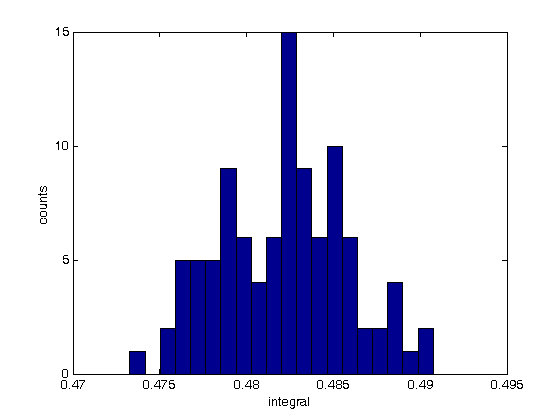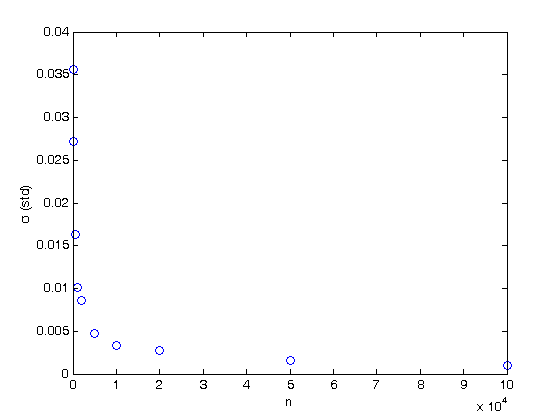% Jake Bobowski % August 16, 2017 % Created using MATLAB R2014a % This tutorial will numerically evaluate a definite integral using the % Monte Carlo "f-average" method. clearvars % In all Monte Carlo simulations it is necessary to generate random or % pseudo-random numbers. The MATLAB command "rand" generates random % numbers uniformly distributed between zero and one. Note that, to % generate random numbers drawn from a normal distribtuion, you can use % "randn". rand % This tutorial will first attempt to evaluate an integral for which the % solution is easily obtained. This approach has been taken purposely so % that we can confirm that our numerical techniques are reliable. The % function that we will integrate is a simply polynomial. Below, the % function is plotted on the interval x = [0, 1] and the exact value of the % integral is evaluated over the same interval. We are going to use this % polynomial over and over again in this tutorial, so we define it as a % function. xx = (0:0.001:1); syms x; fcn = @(x) (-65536*x.^8 + 262144*x.^7 - 409600*x.^6 + 311296*x.^5 - 114688*x.^4 + 16384*x.^3)/27; figure(); plot(xx, fcn(xx), 'k-', 'LineWidth', 1.2) xlabel('x'); ylabel('f(x)'); exact = int(fcn, x, 0, 1) % Convert the exact answer, given as a fraction, to a decimal number. vpa(exact) % The f-average method requires that we repeatedly generate x_i random % numbers (n times) uniformly distributed between the integration interval % (0 to 1 in this example). For each x_i we calculate the corresponding % f(x_i) and sum all of these to find f_total. f_average is obtained % from f_average = f_total/n. An estimate of the integral is given by % the integration interval (b-a)*f_average. In the plot below, we show % each of the f(x_i) and f_average which is our estimate of the integral. % The square area below the red line is approximately equal to the area % beneath the blue curve which is the integral that we're trying to evaluate. n = 1e4; ftot = 0; for i = 1:n xx = rand; xList(i) = xx; fList(i) = fcn(xx); ftot = ftot + fcn(xx); end; favg = ftot/n % Plot the function as a line and the add the hits and misses as scatter % plots. figure(); plot(xList, fList, 'bo') hold on; plot(xList, favg*ones(n, 1), 'r-', 'LineWidth', 3) xlabel('x'); ylabel('f(x)'); hold off; % If you don't need to keep track of the actual coordinates of each % (x, f(x)), then you can get away with a more compact loop keeps a running % total of all the f(x) values. n = 1e4; ftot = 0; for i = 1:n xx = rand; ftot = ftot + fcn(xx); end; favg = ftot/n % Now we will numberically approximate the integral using n = 10,000 one % hundred times and plot the resulting distribution of our determination of % the integral. The distribution is expected to be Gaussian. % To track how long this block of codes take to complete, I'll use the %"datestr" function to display the time before and after the loop. datestr(clock) n = 1e4; for j = 1:100 ftot = 0; for i = 1:n xx = rand; ftot = ftot + fcn(xx); end; intList(j) = ftot/n; end datestr(clock) figure(); nbins = 20; hist(intList, nbins) xlabel('integral'); ylabel('counts'); figure(); % Note that it took MATLAB all of 3 seconds to complette this task. The % same code run in Maple on the same machine requires almost 5 minutes to % complete! % The width of the distribution can be calculated from the standard % deviation of the list of 100 approximations of the integral and is an % estimate in the uncertainty of our determination of the definite integral. % Beleive it or not, the name of the fuction to calculate the standard % deviation of a list is "std"! std(intList) % Finally, the last thing we'll attempt to do is to understand how our % uncertainly (standard deviation) depends on the n. So far, all of our % calculations have used n = 1e4. Now we'll determine the standard % deviation for values of n that range from 100 to 1e5. This % block of code could took my laptop about 46 seconds to complete... % If you've got a lot time to kill, trying running the same loop in Maple! datestr(clock) nList = [100, 200, 500, 1000, 2000, 5000, 1e4, 2e4, 5e4, 1e5]; for k = 1:length(nList) n = nList(k); for j = 1:100 ftot = 0; for i = 1:n xx = rand; ftot = ftot + fcn(xx); end; intList(j) = ftot/n; end nList(k) sigmaList(k) = std(intList); end datestr(clock) % Below we plot the uncertainty in the numerical integral estimation as % a function of n (the number of trials in the Monte Carlo simulation). % As expected, the uncertainty decreases as the number of trials increases. % The sigma values are proportional to 1/sqrt(n). plot(nList, sigmaList, 'bo') xlabel('n') ylabel('\sigma (std)') % To get a better appreciation of the dependence of sigma on n, below we % plot sigma as a function of 1/sqrt(n) and observe the linear relationship % between the two. Beautiful! All of this generated from uniformly % distributed random numbers! Take a moment to reflect on what we've % accomplished. We've used Monte Carlo simulations to study the behaviour % of Monte Carlo simulations! The objective of a Monte Carlo calculation % is always to study the characteristics of some system (often a physical % system) by simulating data using random numbers. figure(); plot(1./sqrt(nList), sigmaList, 'bo') xlabel('1/$$\sqrt{n}$$', 'Interpreter', 'latex') ylabel('\sigma (std)')
ans =
0.1273
exact =
4096/8505
ans =
0.48159905937683715461493239271017
favg =
0.4769
favg =
0.4870
ans =
16-Aug-2017 09:44:47
ans =
16-Aug-2017 09:45:14
ans =
0.0037
ans =
16-Aug-2017 09:45:14
ans =
100
ans =
200
ans =
500
ans =
1000
ans =
2000
ans =
5000
ans =
10000
ans =
20000
ans =
50000
ans =
100000
ans =
16-Aug-2017 09:53:38




